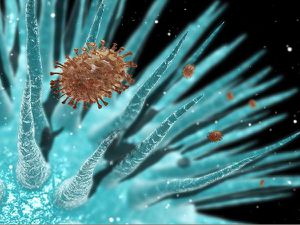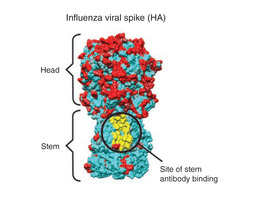Influenza Vaccine: Difference between revisions
| Line 18: | Line 18: | ||
==Antigenic drift and new vaccine targets== | ==Antigenic drift and new vaccine targets== | ||
The | Surface proteins hemagglutinin and neuraminidase are two antigens that are key players in the evolution of the influenza virus. The hemagglutinin protein helps the virus bind to and enter host cells, while the neuraminidase enzyme enables the virus to be released form the host cell as well as helps generate progeny viruses. Both proteins have specific sites that are recognized by the immune systems of the host, so these sites are under strong selection pressure. Particles with mutations that allow the virus to evade attack by common antibodies are selected for by natural selection. These "fit" mutants spread to new people, and new strains evolve. This process is known as antigenic drift. <br><br> | ||
Mutations occur quite often in the RNA virus as the virus' RNA polymerase lacks a proofreading mechanism. | |||
The current vaccines produce antibodies that recognize a protein on the outer coating of the virus called hemagglutinin, focusing on the "head" region of the molecule (see figure 2). But this "head" region is a part of the virus that is very susceptible to antigenic drift. | The current vaccines produce antibodies that recognize a protein on the outer coating of the virus called hemagglutinin, focusing on the "head" region of the molecule (see figure 2). But this "head" region is a part of the virus that is very susceptible to antigenic drift. | ||
Revision as of 16:48, 7 November 2013
Introduction
The influenza vaccine is a highly controversial vaccine, and has several unique qualities that make it an especially interesting topic of research.
Vaccines work by exposing the body to the right antibodies to fight a particular disease. (more about how vaccines work)
But, the influenza virus is a rapidly evolving pathogen. The virus evolves enough from season to season that a new dose of the vaccine is necessary every year, as last year's antibodies usually can not recognize this year's strain. See antigenic drift section.

Other examples:
Bold
Italic
Subscript: H2O
Superscript: Fe3+
Antigenic drift and new vaccine targets
Surface proteins hemagglutinin and neuraminidase are two antigens that are key players in the evolution of the influenza virus. The hemagglutinin protein helps the virus bind to and enter host cells, while the neuraminidase enzyme enables the virus to be released form the host cell as well as helps generate progeny viruses. Both proteins have specific sites that are recognized by the immune systems of the host, so these sites are under strong selection pressure. Particles with mutations that allow the virus to evade attack by common antibodies are selected for by natural selection. These "fit" mutants spread to new people, and new strains evolve. This process is known as antigenic drift.
Mutations occur quite often in the RNA virus as the virus' RNA polymerase lacks a proofreading mechanism.
The current vaccines produce antibodies that recognize a protein on the outer coating of the virus called hemagglutinin, focusing on the "head" region of the molecule (see figure 2). But this "head" region is a part of the virus that is very susceptible to antigenic drift.

Section 2
Include some current research, with a second image.
Conclusion
Overall text length should be at least 1,000 words (before counting references), with at least 2 images. Include at least 5 references under Reference section.
References
Edited by [Author Name], student of Joan Slonczewski for BIOL 116 Information in Living Systems, 2013, Kenyon College.
